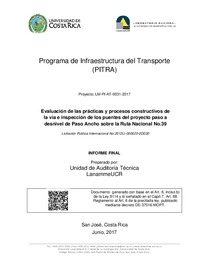Evaluación de las prácticas y procesos constructivos de la vía e inspección de los puentes del proyecto paso a desnivel de Paso Ancho sobre la Ruta Nacional No.39
Date
2017-06-01Author
Acosta Hernández, Erick
Hidalgo Arroyo, Ana Elena
Fonseca Chaves, Francisco
Sequeira Rojas, Wendy
Loría Salazar, Luis Guillermo
Metadata
Show full item recordAbstract
The constructive process: The vertical deflections obtained by the LanammeUCR show a high variability in the results, when comparing these values, with the values obtained in other similar projects turn out to be high.
Granular material was placed as a filler to mitigate the effect of water on the subgrade.
The final layer of asphalt mix, in some sections, was placed on a stabilized base layer that had non-conformities related to noncompliance in the compaction specification.
Pavement structures placed on site are not traceable with respect to the location declared by the Administration.
The use of "traba" on the riego de liga recently placed on the stabilized base layer was observed. The detrimental effects that this practice has on the adhesion between layers are known.
The first layer mixed asphalt of the ramps of the axes No. 3 and 5, presented premature deterioration, which forced to carry out interventions of maintenance and reinforcement, before placing the second layer of mixture. This situation generated a complaint to the Administration for additional costs.
Some of the trapping grids have part of their area available to evacuate blocked, because they are supported on a concrete element that restricts its hydraulic capacity.
Quality of materials:
Reinforcing steel: Deficiencies were detected in the corrugation height specification and in the control of quality certificates.
Concrete of the lateral walls: The presence of cracks of different degrees of severity was detected. In some cases, the leakage of fine material (soil) and water through cracks has been observed.
Bridge inspection:
The construction drawings and the approved calculation memory do not present information on the construction procedures, parameters and evaluations that must be carried out during the structural design
The bridges entered into operation with deteriorated elements (supports, slab of approach and expansion joints) and repairs pending execution even though they were identified during the construction process.

